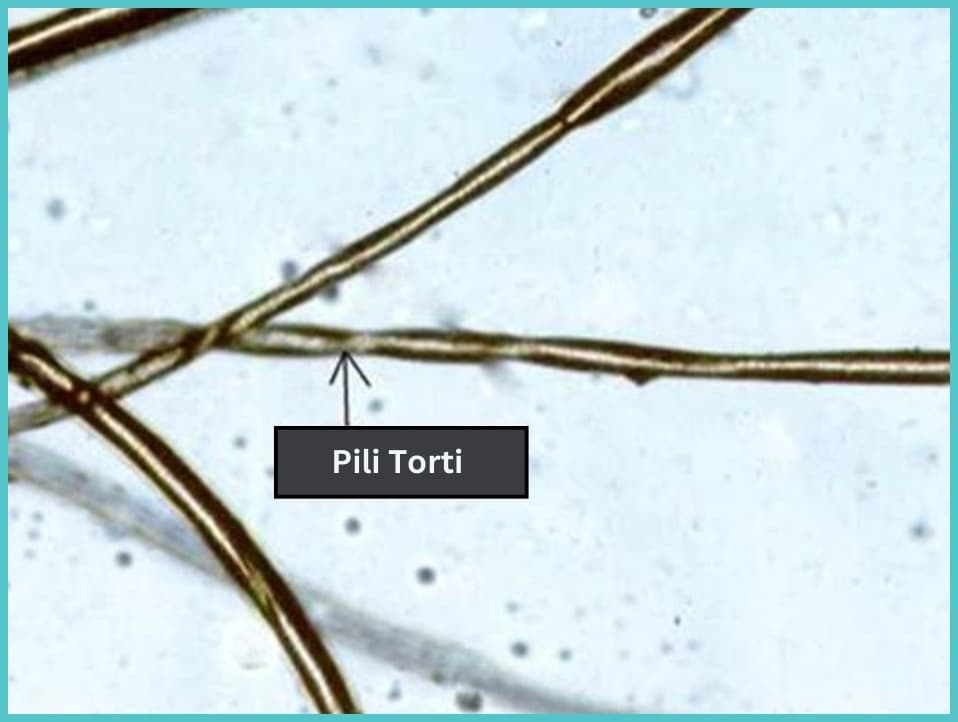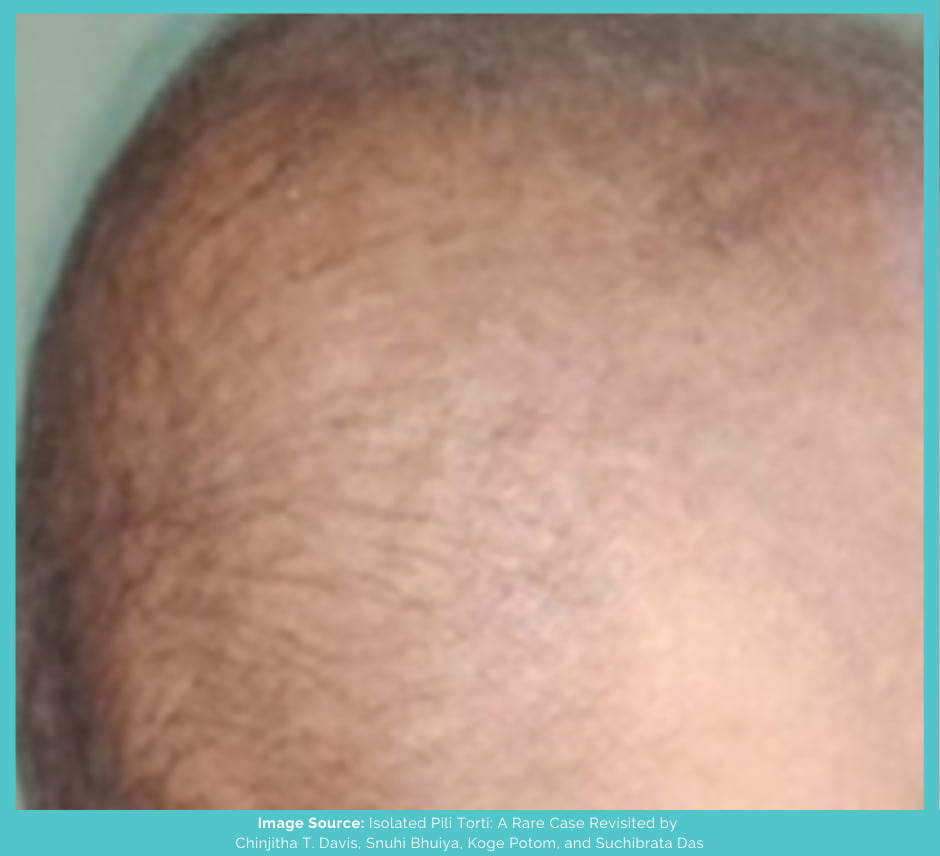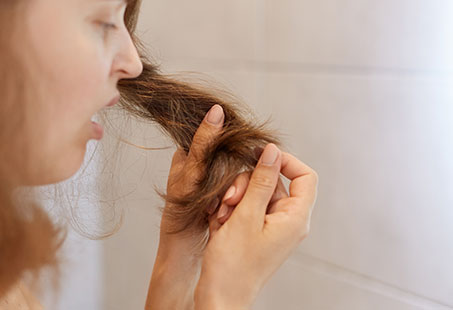Pili torti, also known as twisted hair, is a rare disorder of the shaft that can be inherited or acquired. The reason why it’s called twisted hair is that it literally twists the strand of hair.
It doesn’t always affect the entire scalp. In fact, it’s even possible for some people to not realise that they have this condition.
In some instances, this condition resolves on its own, but it can affect individuals throughout their lifetime as well.
Unfortunately, this condition cannot be treated. But there are some things that you can do to better take care of your hair if you have pili torti.
What Is Pili Torti?
Pili torti is characterised by the presence of flattened hair at irregular intervals along the length of the hair shaft (not always entirely). On top of that, however, it’s twisted 180°.

It can affect the entire scalp, but the back of the head and above the ears is where it occurs more commonly. But it’s not always diffuse. Actually, it’s more likely to affect specific (localised) areas.
And it doesn’t only occur on the scalp, either. Pili torti can also affect the following areas on your face and body:
- Eyebrows
- Eyelashes
- Armpits
- Pubic area
Keep in mind that the degree of the severity of this condition can vary between patients. In some cases, it’s so mild that nothing seems obviously wrong with the hair. But at other times, it can be severe enough to last a lifetime.
What Are The Different Types Of Pili Torti?
There are two types of pili torti, which are as follows:
Inherited Pili Torti
Inherited pili torti, as the name suggests, is when you get the condition from your parents as a result of faulty genes.
You might develop it after receiving the mutated gene from both of your parents (autosomal recessive) or even just one of them (autosomal dominant). It’s further classified into the following categories:
- Early Onset (Ronchese) Type – It’s when this condition develops in isolation during early childhood. According to a study published in the Archives of Pediatrics and Adolescent Medicine, it can affect children between the ages of 2 and 24 months. This type of pili torti gets better as the child gets older, especially after they hit puberty.
- Late Onset (Beare) Type – This type of pili torti usually occurs after puberty. It can affect the face, body and the scalp of the person and is more common in people with darker hair (unlike blonde in the early onset type).
There’s another category of inherited pili torti, but it’s when this condition occurs in combination with another illness (instead of developing in isolation) like:
- Netherton syndrome
- Menkes disease
- Björnstad syndrome
- Bazex-Dupré-Christol syndrome
- Ankyloblepharon-ectodermal defects-cleft lip/palate (AEC) syndrome
- Rapp-Hodgkin syndrome
Acquired Pili Torti
The person with acquired pili torti is not born with this condition, but rather develops it for various reasons. According to the National Organization for Rare Disorders (NORD), this can be due to:
- Malnutrition (including anorexia nervosa)
- Oral retinoids
- Scalp inflammation (like in scarring alopecia)
According to a study published in the Journal of Clinical Medicine, it’s believed that acquired pili torti develops when inflammation indirectly produces “rotational forces” when end up deforming the hair follicle.
The researchers of the same study have also outlined many other health problems and even different types of hair loss associated with acquired pili torti, some of which are:
- Scarring alopecia – for e.g. lichen planopilaris, frontal fibrosing alopecia, central centrifugal cicatricial alopecia, chronic traction alopecia, folliculitis decalvans, etc.)
- Autoimmune diseases – for e.g. alopecia areata, discoid lupus erythematosus, systemic sclerosis or pseudopelade of Brocq
- Neoplastic diseases – for e.g. cutaneous T-cell lymphoma, scalp metastases from breast cancer (happens very rarely),
- Systemic disorder – for e.g. graft-versus-host disease
What Does Pili Torti Look Like?
Symptoms of pili torti can include:
- Coarse, stiff and dry hair
- Brittle hair that shimmers when light is reflected on it
- Fragile and easily breakable hair
- Short hair
- Cluster of twists of hair (early onset pili torti)
- Single twist of hair (late onset pili torti)
Keep in mind it may vary depending on the type of pili torti you have. Moreover, some of the conditions associated with pili torti can have other hair shaft disorders associated with them as well.

What Causes Pili Torti?
Pili torti can be caused by abnormal genes, inflammation, issues with nutrition, health problems or the intake of certain drugs. It can be congenital or acquired.
As far as the genetic pili torti is concerned, as mentioned above, it can be caused by the inheritance of the faulty gene from the mother/father or both.
And in cases of acquired pili torti, it’s believed that there’s excess scar tissue around the hair follicle, which ends up “moulding” and deforming it.
What Is The Treatment For Pili Torti Hair?
Unfortunately, there’s no trement for pili torti. However, your doctor may recommend the use of topical minoxidil to improve the quality of your hair.
But the good news is that this condition can go away on its own. You can grow out your inherited pili torti. And some cases of acquired pili torti may also be fixed. In any case, you must consult a medical professional about this.
On your end, since the hair’s already quite fragile and easily breakable, you must be careful in its handling.
For instance, you shouldn’t tie it too tightly or further traumatise it through pressure or friction. Strong chemicals in hairstyling or haircare products may also cause further damage, so opt for something gentler.
Conclusion
Pili torti can be a difficult hair shaft disorder to deal with, especially since it has no treatment. It can leave the hair dry, lustreless, short and coarse and cause significant aesthetic concerns among those experiencing it.
Fortunately though, this condition is not always permanent for everyone. It can get better with time or it may resolve if the underlying problem is treated. Whatever may be the case, if you’re losing your hair, you need an accurate diagnosis by your doctor.
There are many reasons why hair loss can occur. Some conditions can closely resemble others, so you shouldn’t start any hair loss treatment without consulting a board-certified doctor. Depending on your problem, they’ll create a personalised treatment plan for you.
Reviewed and Approved by Trichologist Yaprak Yazan


